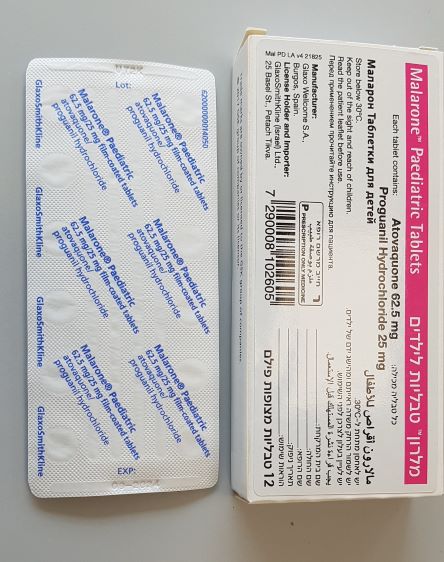Quest for the right Drug

מלרון טבליות לילדים MALARONE PAEDIATRIC TABLETS (ATOVAQUONE, PROGUANIL HYDROCHLORIDE)
תרופה במרשם
תרופה בסל
נרקוטיקה
ציטוטוקסיקה
צורת מתן:
פומי : PER OS
צורת מינון:
טבליות מצופות פילם : FILM COATED TABLETS
עלון לרופא
מינוניםPosology התוויות
Indications תופעות לוואי
Adverse reactions התוויות נגד
Contraindications אינטראקציות
Interactions מינון יתר
Overdose הריון/הנקה
Pregnancy & Lactation אוכלוסיות מיוחדות
Special populations תכונות פרמקולוגיות
Pharmacological properties מידע רוקחי
Pharmaceutical particulars אזהרת שימוש
Special Warning עלון לרופא
Physicians Leaflet
Interactions : אינטראקציות
4.5 Interaction with other medicinal products and other forms of interaction Concomitant administration of rifampicin or rifabutin is not recommended as it is known to reduce plasma concentrations of atovaquone levels by approximately 50% and 34%, respectively (see section 4.4). Concomitant treatment with metoclopramide has been associated with a significant decrease (about 50 %) in plasma concentrations of atovaquone (see section 4.4). Another antiemetic treatment should be given. Although some children have received concomitant Malarone and metoclopramide in clinical trials without any evidence of decreased protection against malaria, the possibility of a clinically significant drug interaction cannot be ruled out. When given with efavirenz or boosted protease-inhibitors, atovaquone concentrations have been observed to decrease as much as 75%. This combination should be avoided whenever possible (see section 4.4) Proguanil may potentiate the anticoagulant effect of warfarin and other coumarin based anticoagulants which may lead to an increase in the risk of haemorrhage. The mechanism of this potential drug interaction has not been established. Caution is advised when initiating or withdrawing malaria prophylaxis or treatment with atovaquone-proguanil in patients on continuous treatment with oral anticoagulants. The dose of the oral anticoagulant may need to be adjusted during Malarone treatment or after its withdrawal, based on INR results. Concomitant treatment with tetracycline has been associated with decreases in plasma concentrations of atovaquone. The co-administration of atovaquone at doses of 45mg/kg/day in children (n=9) with acute lymphoblastic leukaemia for prophylaxis of PCP was found to increase the plasma concentrations (AUC) of etoposide and its metabolite etoposide catechol by a median of 8.6% (P=0.055) and 28.4% (P=0.031) (respectively compared to the co-administration of etoposide and sulfamethoxazole- trimethoprim). Caution should be advised in patients receiving concomitant therapy with etoposide (see section 4.4). Proguanil is primarily metabolised by CYP2C19. However, potential pharmacokinetic interactions with other substrates, inhibitors (e.g. moclobemide, fluvoxamine) or inducers (e.g. artemisinin, carbamazepine) of CYP2C19 are unknown (see section 5.2).

שימוש לפי פנקס קופ''ח כללית 1994
לא צוין
תאריך הכללה מקורי בסל
לא צוין
הגבלות
לא צוין
מידע נוסף
